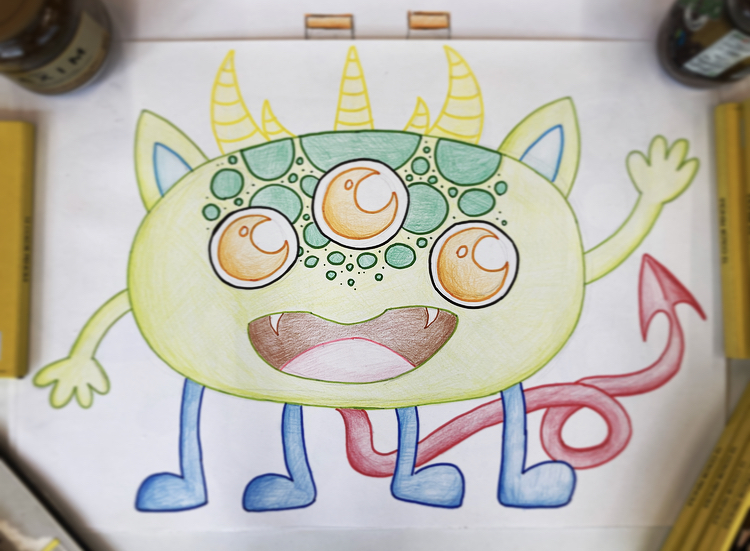This article originally featured in the October 2021 issue of Connect.
Future Tense – Halloween Fortune Tellers
Rachel Fagundes (Okayama)
I’m a fiend for Halloween, so from the first of October—it’s ON. Students love anything to do with witches and ghosts, but most JHS teachers are busy just getting through the textbook and don’t have time to spend just talking about the holiday.

So instead, I incorporate Halloween into every grammar lesson and activity that I do throughout the month. Are we practicing “I know how to” phrases? Great! It’s time for the students to learn how to kill vampires, and so on and so forth.
The point is to get students engaged and excited to use the language they have been learning in class by putting a Halloween spin on your English activities.
Here is one of my lesson plans from the merry month of October.
Grade Level: JHS 2nd Year
Goal: Speaking, Listening, Writing.
Future tense questions and answers.
My students learn the future tense in October, so instead of having them ask each other the usual dull questions (“Will you study English tomorrow?” / “Yes, I will.”) we use Halloween themed “cootie catchers” (the folded paper fortune tellers of your middle school slumber parties) to peer into the mysteries of the future.
What you need:
Prep:
Print out worksheets and the cootie catchers. Cut the extra paper away from the cootie catchers. This will make it easy for the kids to fold them quickly in class.
Also, talk to your JTE about how cootie catchers work and practice the demonstration with them.
In class:
Hand out the worksheets and walk the kids through the grammar of asking spooky questions. “Will I see a ghost tomorrow?”, “Will I marry a vampire?”, and “Will I become a werewolf on Halloween?” are examples I like to use, since they give students the grammar they need for the ever-popular questions: “Will I marry [insert crush’s name here]?” and “Will I become a [insert dream job here]?”
Have the students brainstorm and write their own questions on their worksheets. They can be spooky Halloween themed or not, whatever the students want to ask, they just can’t be identical to the examples provided.
Demonstrate with JTE using the cootie catchers to ask and answer questions. Instructions are a bit complicated for those unfamiliar, so they are also written in Japanese on the worksheet.
Hand out the cootie catchers and show the students how to fold them.
Have the students make pairs and ask one another questions using their cootie catchers to answer.
Students then write down responses on their worksheets.
Rachel Fagundes is an unstoppable Halloween machine who spends the other 11 months of the year waiting for October. She is also the Head Editor of [CONNECT].
Spooky Scary Study
Dahlia Lamelin (Gunma)
For elementary school children who don’t yet know how to read or write, teachers need to get a little creative with activities that are both fun and educational. For holidays, I always make sure to include some level of review and plan lessons accordingly. For third and fourth grade, I use a lot of resources from islCollective, which I modify to suit my students and their level, adding a sprinkle of fun on top.
DahliaLemelin01- 4th gradeHalloween comes around at the same time as the alphabet unit in the Let’s Try textbook, so I focus on making them see and recognize letters with a themed word search. With some vocabulary picture cards as a warm-up practice, we focus on repeating along with scary gestures related to the theme. The focus being on matching upper and lowercase letters in a word search activity for fourth grade vocabulary words. This is a good introduction to the variations of the alphabet. For lower-level students or even special needs classes, simply deciphering the words and matching the pictures is a possible alternative. The children who finish first can color the images while waiting for the next activity and no one feels left behind.
As for 3rd grade, October arrives after lessons presenting colors, numbers, and feelings, so it comes as a perfect opportunity to review while making it entertaining. With this worksheet, they have to match the emotional pumpkins with the vocabulary and draw the one remaining unmatched expression on the last blank gourd. As a last review, the color-by-number picture familiarizes them with the colors and their spelling, as well as their pronunciation via katakana. These activities go well for most levels and are a delight with a spooky playlist or a Halloween-themed video played in class while they finish their worksheets. Spooky Scary Study!
DahliaLemelin02- 3rd gradeDahlia is a 4th year JET that likes getting lost in the country side and promoting the spooky lifestyle.
Monster Mash
Meg Lue (Fukui)
One of my favorite Halloween activities to do with my kids is a drawing game I call Monster Mash! This game is really easy, requires very little prep time, and is extremely flexible. It can be as short as 10 minutes and take up to as much as 30 or more. All you will need is a monster you created (before class), some whiteboard and whiteboard markers, and your best Halloween mask (last item optional for kicks and giggles). For reference, I teach Junior High, though this activity could easily be adapted for all learner levels!
To start, I draw a couple simple monsters on the board, ask my students what they are, then review their names in English as a little warm-up. After the warm-up, I tell my kids that I saw a monster the other day, but I need their help to draw it so I can see it again! I have them break up into teams while I pass out whiteboards and tell the kids that I will describe the monster I saw to them. How easy or difficult each of these descriptors are can depend on what grade level you’re teaching. You can use something as simple as “It had three arms” or something as complex as “It had two long arms on the right side and one short arm on the left.” If you do this activity with paper and markers you can also throw color descriptors into the mix too.
Tip 1: It’s best to start with describing the body and head of the monster, so the students know where to place everything else!
Tip 2: Before the game you might need to teach the English for less humanistic descriptions that wouldn’t normally be in their vocabulary, like tails, horns, wings, etc.
After each description, have the students pass the whiteboard to the next student, to make sure that everyone in the group gets at least one chance to draw and add something to the creature.
 Once you have finished describing your monster, have the kids bring their whiteboards to the front so that the class can see the monster that each team drew, and there are definitely some chaotic drawings that happen. Now you can reveal the monster you drew before class, and the team with the monster most similar to your own is the prize winner!
Once you have finished describing your monster, have the kids bring their whiteboards to the front so that the class can see the monster that each team drew, and there are definitely some chaotic drawings that happen. Now you can reveal the monster you drew before class, and the team with the monster most similar to your own is the prize winner!
Meg Luedtke is a 3rd year JET living the small town life who enjoys all things travel, art, and Japan related. Halloween is her favorite holiday so she often has a great deal of fun teaching the kids how to “trick-or-treat,” a trick her students often end up using to pester their other teachers.
The Pumpkin Face Game
Dianne Yett (Gunma)
This is a game that a friend of mine shared with me, which I’ve used with my third-year elementary school students before, but the game is perfect for any grade level. I created 15-17 large playmats out of discarded poster paper, each roughly A3-sized or bigger (big enough to have a large playing field but small enough to fit on a student’s desk). Each playmat has a large pumpkin drawn and colored with markers (or the mats can be giant cut-outs of pumpkins). Then I made an equal number of envelopes containing construction paper cut-outs of all the face pieces needed: two eyes, a nose, and a mouth. You can make the pieces look any way you want, but basic triangles for the eyes and nose work. I cut out the mouths in the shapes of classic jack-o-lantern mouths with block teeth.

For demonstrating the game, I made extra face pieces backed with magnets to stick to the blackboard and hung one of the playmats up with magnets. Students play the game in pairs, with one student blindfolded (or closing their eyes) while the other student directs the blindfolded student with any of the following commands: “Up!” “Down!” “Left!” “Right!” and “Stop!” The blindfolded student will take a face piece, start anywhere on the playmat,and move the piece in the direction of their partner’s commands until they hear “STOP.” Then the blindfolded student will let go without looking and take the next face piece. The process continues until all face pieces have been placed, at which point the blindfolded student may look at the resultant jack-o-lantern face and laugh at the absurdity. After the first try, the students can switch roles as often as time allows, and that’s the game!
Dianne is an Assistant Language Teacher in Gunma Prefecture and Copy Editor for [CONNECT]. Halloween is her second favorite holiday because she likes using it as an excuse to cosplay outside of anime conventions. It is second only to Christmas, which is also her birthday.
Spooky Fly Swatter Vocabulary Race
Sami Marks (Ishikawa)
Grade Level: Elementary School, first and second grade
Materials: Halloween-themed vocabulary cards, fly swatters (1 for each team), stickers as prizes
Time: ~15 minutes
Lesson Plan:
- (5 minutes) First, introduce the students to the target vocabulary. Show the vocabulary card, say the word aloud, and have the students repeat after you at least two times. Go through all the cards, then run through once more at the end to ensure comprehension.
Now it’s time for the fun to begin.
- Divide the class into teams, then have the students make lines behind their team leader (or whoever’s at the front of the column).
- Give the first person in the line a fly swatter (or whatever other soft pointer-type thing you have. I once used fluffy cat toys.)
- Display the cards on the board. Make sure none of them are too high that the smaller children can’t reach them with the fly swatter. Repeat the vocabulary words one more time for review.
Go!
- And the game begins. When you say a word, the first students must run to the board and touch the correct card with the fly swatter. If they get it right, their team gets a point.
- The first student then returns to their team and hands the fly swatter to the next student in line as they move to the back.
- Repeat. Team with the most points wins! Give stickers out generously.
Sami is an ALT in Ishikawa favoring the brutally honest yet cute ES students over the feisty JHS students any day.




